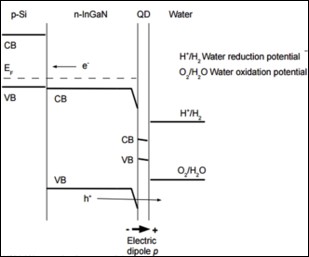Solar hydrogen is a clean and storable source of energy. We present a novel InGaN/InN quantum dot photo-anode that can promote direct conversion of solar radiation into zero-impact hydrogen. The technology is cost effective and can be implemented into commercial Si solar cells. The electrode exhibits high resistance to degradation and thanks to the addition of InN quantum dots can lead to almost 10% efficiency without the aid of an external bias.

Patent Status
GRANTED

Priority Number
102016000076708

Priority Date
21/07/2016

License
INTERNATIONAL
Market
Due to rising concerns regarding climate a transition towards renewable energy instead of fossil fuels is necessary. Green hydrogen market is increasing and is expected to reach a market size of USD 2.5 Billion by 2028. The Department of Energy (USA) targeted final costs of hydrogen produced by photoelectrochemical water splitting is set at 5.7 $/kg . The ultimate hydrogen cost target for any production method available is 2-3 $/kg. Altogether our InN/InGaN photoelectrode shows superior and clean performances and meets all the targets of now and in the future to be fully market competitive.
Problem
In 2020 the CO2 concentration in air exceeded 400 ppm and the global temperature was 1.2°C hotter than the average year in the 19th century. To the present day fossil fuels still supply more than 80% of the world energy. 1 tonn of oil equivalent used results in 2.7 tonns of CO2. The carbon emission is not sustainable anymore and an energy transition towards renewable sources is necessary. Despite their undeniable social and economic advantages, renewable energies still suffer from critical issues, such as the the difficult storing of the electrical energy produced to cope with the intermittency of the natural sources. Hydrogen is a storable energy source that can be recombined with oxigen in fuel cells to produce energy on demand, having water as the only byproduct. Unfortunately, hydrogen fuel does not exist naturally and must be produced. Today over 90% of the hydrogen is produced from fossil fuels, resulting in the emission of carbon pollutant in the air. Solar hydrogen is the optimum solution for a clean, renewable and environmental friendly fuel to provide reliable, steady supply of energy.
Current Technology Limitations
As of 2020, 95% of the hydrogen is produced from fossil fuels by steam reforming (grey) or coal gasification (brown). These processes result in 10 kg of carbon waste per kg of hydrogen produced. Blue hydrogen has a lower carbon print due to the capture of 80-90% of the CO2 produced. However this process is not 100% carbon-free and suffers from the added step to capture and store the CO2. Hydrogen can be produced by alkaline water electrolysis or protone exchange membrane electrolysis. These processes require high applied overvoltages, components that can resist to harsh alkaline/acidic environments and rare and expensive catalysts such as Pt, Ir or Ru. Another approach is the use of solar energy to split water into hydrogen and oxygen. Currently, the two main routes pursued for solar hydrogen generation are based on (i) wide-bandgap metal oxides or III-V semiconductors used as photoelectrodes for direct photoelectrochemical water splitting; and (ii) photovoltaic cells for catalyst-assisted water electrolysis. These technologies ideally do not require the aid of an external bias, however they both suffer from poor efficiency levels and limited resistance to degradation. These approaches often request the use of expensive co-catalysts.
Killer Application
Our device is a novel photoelectrode based on InN/InGaN quantum dots for direct solar hydrogen generation by water splitting with record efficiency and stability. The electrode is grown on Si substrate to allow a direct integration into a commercial Si-based solar cell in order to produce a fully autonomous photocatalytic system with competitive value of solar-to-hydrogen efficiency. The electrode can be developed onto flexible surfaces for easier introduction in standard or more complex photocatalytic systems.
Our Technology and Solutions
This novel InGaN/InN photo-anode promotes the direct conversion of white light into zero-impact hydrogen. The InGaN layer can be grown directly on economically viable Si substrates via Molecular Beam Epitaxy (MBE). InGaN exhibits high resistance to degradation and wide bandgap tunability, thus making it optimal candidate for photocatalysis applications. The electrode is submerged in water and exposed to white light. The InGaN layer can absorb the optimal amount of solar radiation to promote the oxidation of water into O2 without any energy dispersion. The photocurrent generated inside the semiconductor drives the electrons to the working counter-electrode, on the surface of which H2 is produced. InN quantum dots can be grown in-situ directly on the InGaN surface via MBE. The quantum dots can enhance the electrode efficiency by 50% compared to bare InGaN. InGaN/InN properties alone allow to drive photo-electrochemical water splitting with almost 10% efficiency without an external voltage or the addition of a co-catalyst that could reduce the radiation adsorption. The electrode can be directly integrated into a commercial solar cell to obtain a high stability and high efficiency autonomous system. The technology can be developed onto wide or flexible surfaces and easily introduced as a photocatalytic stage into traditional systems where the catalytic bias is provided by external photovoltaic cells.
Advantages
Our electrode promotes water-splitting without the aid of an external bias or expensive catalysts. The hydrogen generated with this technology is 100% carbon-free. The Si substrate makes our electrode economically viable and allows direct integration into existing Si-based technology. The InGaN layer electronic properties can be tailored to optimize charge transport and radiation adsorption. InGaN exhibits an excellent resistance to degradation compared to other semiconductors. InN quantum dots enhance the efficiency of the electrode and can be grown in-situ, thus saving time and materials.
Roadmap
The product which forms the base of the business is an InN/InGaN quantum dot photoanode for solar hydrogen generation by water splitting which can be integrated with a commercial Si photovoltaic cell to form a hybrid device with maximized efficiency. The plan is to produce the photoanode and deliver it to established companies for full system fabrication. Future planning regards (i) the integration of the photoelectrode with a commercial Si solar cell which can boost the efficiency of a fully autonomous system (ii) the transfer to mass production technologies like metal organic vapor phase epitaxy.
TRL
Team










